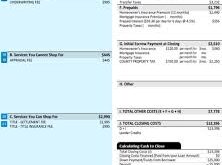Mortgage Debt Ratio: Calculation and Best Practices. The mortgage debt ratio is a crucial financial metric used by lenders to determine a borrower’s ability to repay a home loan. It compares a borrower’s monthly housing expenses to their gross monthly income. Mortgage lenders use this ratio to assess financial risk and decide loan approval terms.
There are two primary types of mortgage debt ratios:
- Front-end ratio: This measures housing costs, including mortgage payments, property taxes, homeowner’s insurance, and HOA fees.
- Back-end ratio: This includes all debt obligations, such as credit card payments, car loans, student loans, and other financial commitments.
Why Mortgage Debt Ratio Matters
Lenders use mortgage debt ratios to evaluate creditworthiness and financial stability. A lower ratio indicates a stronger ability to handle mortgage payments, increasing the chances of loan approval. Conversely, a high ratio may result in loan denial or higher interest rates due to increased risk.
How to Calculate Mortgage Debt Ratio
The mortgage debt ratio is calculated using these formulas:
- Front-End Ratio Formula:
- Back-End Ratio Formula:
Example Calculation:
- Gross monthly income: $6,000
- Monthly housing costs (mortgage, taxes, insurance): $1,500
- Total monthly debt payments: $2,200
Front-end ratio: (1,500 / 6,000) × 100% = 25% Back-end ratio: (2,200 / 6,000) × 100% = 36.67%
Lenders typically prefer a front-end ratio below 28% and a back-end ratio below 43%.
Recommended Mortgage Debt Ratio Limits
- Conventional Loans: Front-end ratio ≤ 28%, back-end ratio ≤ 36%
- FHA Loans: Front-end ratio ≤ 31%, back-end ratio ≤ 43%
- VA Loans: Flexible, but generally back-end ratio ≤ 41%
- USDA Loans: Front-end ratio ≤ 29%, back-end ratio ≤ 41%
How to Improve Your Mortgage Debt Ratio
- Increase Income – Boost your earnings through side jobs or career advancements.
- Reduce Debt – Pay off existing loans, such as credit card balances or auto loans.
- Refinance Loans – Lower your mortgage payment with better interest rates.
- Improve Credit Score – A higher credit score can help you qualify for better loan terms.
- Avoid New Debt – Limit additional financial obligations before applying for a mortgage.
- Make a Larger Down Payment – A higher down payment reduces the loan amount and improves the ratio.
- Extend Loan Terms – Longer mortgage terms lower monthly payments but may increase total interest costs.
- Stick to a Budget – Monitor your spending to keep financial obligations in check.
- Consider a Co-Signer – A co-signer with strong financials can improve your loan approval odds.
- Negotiate Debt Settlement – Work with creditors to lower outstanding debt balances.
10 Essential Tips for Managing Mortgage Debt Ratio
- Always calculate your mortgage debt ratio before applying for a home loan.
- Aim for a front-end ratio below 28% for conventional loans.
- Keep your back-end ratio under 36% for better loan eligibility.
- Reduce outstanding debts before applying for a mortgage.
- Avoid co-signing loans that increase your debt obligations.
- Consider government-backed loans if you have a high debt ratio.
- Save for a higher down payment to reduce loan amounts.
- Use mortgage calculators to estimate your potential debt ratio.
- Regularly check your credit report for accuracy.
- Work with a financial advisor to optimize your debt-to-income ratio.
10 Frequently Asked Questions (FAQs)
1. What is a good mortgage debt ratio?
A good mortgage debt ratio is a front-end ratio below 28% and a back-end ratio below 36%.
2. Can I get a mortgage with a high debt ratio?
Yes, but you may face higher interest rates or need a co-signer or a larger down payment.
3. How does my credit score affect my mortgage debt ratio?
A higher credit score improves your chances of loan approval even with a higher debt ratio.
4. Do all lenders use the same mortgage debt scale limits?
No, different lenders and loan types have varying mortgage debt scale requirements.
5. Can student loans impact my mortgage debt scale?
Yes, student loan payments are included in the back-end scale calculation.
6. Will paying off a car loan lower my mortgage debt scale?
Yes, eliminating a car loan reduces your overall debt and improves your debt scale.
7. How often should I check my mortgage debt ratio?
Check your mortgage debt scale before applying for a mortgage or refinancing.
8. What if my mortgage debt scaleis too high?
Consider increasing income, reducing debt, or opting for a government-backed loan.
9. Can I refinance my mortgage to improve my debt scale?
Yes, refinancing to a lower interest rate can reduce monthly payments and improve your ratio.
10. Do mortgage lenders consider future income increases?
Typically, lenders base approvals on current income, but strong job prospects may be considered.
Conclusion
The mortgage debt scale is a key factor in determining mortgage approval and affordability. Understanding and maintaining a healthy debt ratio increases your chances of securing favorable loan terms. By managing income, reducing debt, and making informed financial decisions, you can achieve a more favorable mortgage debt scale.
Whether you are a first-time homebuyer or refinancing an existing loan, optimizing your mortgage debt scale will help you secure the best possible terms. Always review your financial situation, set realistic budgeting goals, and consult financial experts to improve your mortgage eligibility and long-term financial stability.
 mortgage.kbk.news
mortgage.kbk.news
